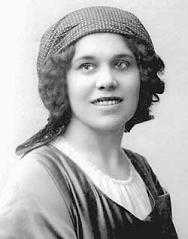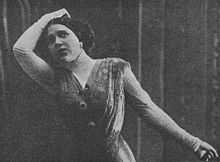Nadezhda Plevitskaya

Nadezhda Vasilievna Plevitskaya (Russian: Надежда Васильевна Плевицкая; born Vinnikova, Russian: Винникова; 17 January 1884 – 1 October 1940) was the most popular female Russian singer of the White emigration.
Early life and career
Plevitskaya was born Nadezhda Vasilievna Vinnikova to a peasant family in the village of Vinnikovo near Kursk. She loved to sing, and after two years in a religious chorus she became a professional singer in Kiev, where she married Edmund Plewicki, a Polish dancer. Soon they moved to Moscow, where she began singing in the well-known Yar restaurant, whose specialty was gypsy bands with beautiful female singers, and going on tour; at a concert in 1909 at the Nizhny Novgorod fair, she was heard by the great tenor Leonid Sobinov, who brought her to the attention of a wider public, which soon included the Imperial family as well as Feodor Chaliapin.

A Russian song site[1] says:
| “ | Plevitskaya possessed a rare musicality, lush and flexible, and a mezzo-soprano of wide range. Her repertoire included, alongside popular ditties of mediocre quality, superb examples of Russian peasant folksong from Kursk province as well as songs of city life that are still meaningful today. Her manner of performance showed great sincerity, rich intonation, expressive declamation, and an unusually subtle and deep feeling for the beauty of Russian speech. | ” |
She married again, this time to a Lieutenant Shangin of the Cuirassiers, but he died in battle in January 1915. After the October Revolution she became a communist and Bolshevik, and continued singing for the troops of the Red Army. In 1919 she was captured by a unit of the White Army commanded by General Nikolai Skoblin, who married her in exile in Turkey after the defeat of the White military forces.
Later life
Exile in Europe
Plevitskya made concert tours throughout Europe (and, in 1926, to the United States, where she was accompanied by Sergei Rachmaninoff), while her husband, General Skoblin, took a leading role in a White émigré organization, the ROVS. It was there that Rachmaninoff heard her sing the song "You, My Cerise, My Rouge" (Белилицы, румяницы вы мои; Belilitsy, rumyanitsy vy moyi), which he used as the basis of the last of his Three Russian Songs for chorus and orchestra. However, neither career produced much income for Plevitskaya or Skoblin. Plevitskaya, a woman known to love the fine furs and jewelry worn by affluent women in the West, persuaded her husband to work for the Soviet Union.[2]
Soviet intelligence agent
In 1930, Plevitskaya and her husband were recruited by the GPU, (later, the NKVD), the Soviet secret police. During a period of time, they worked together with group of Sergei Efron.[3] By all accounts, they served as accomplished and highly successful agents of Soviet intelligence.[4] At first, the couple were used on assignments in Western Europe. However, their success soon resulted in periodic covert trips back to the Soviet Union, where she and Skoblin performed well-paid counter-intelligence work in Moscow for the NKVD uncovering 'enemies of Stalin' while posing as 'Mr. and Mrs. Grozovsky.' Working under a variety of guises for the Soviet Central Executive Committee and the Foreign Trade Comissariat, Nadezhda Plevitskaya, under the pseudoymn 'Mrs. Grozovsky,' would appear for work at a Soviet government office as an extremely well-dressed typist-clerk, complete with lacquered nails, jewelry, and well-tended skin, where she faithfully reported on the actions and statements of its personnel.[5]
Plevitskaya and Skoblin were also involved in the infamous 1937 abduction of General Evgenii Miller, who was kidnapped in Paris, drugged, and taken back to Moscow, where he was executed after being tortured for nineteen months in May 1938. After the kidnapping, Skoblin escaped to Barcelona, where the Spanish Republican government, kept alive by Soviet aid, refused to extradite him back to France. Plevitskaya, always chauffeured around France by Soviet NKVD drivers in a Soviet embassy Cadillac, was constantly followed by the French police Citroens.[6] She successfully lost her police surveillance in a high-speed auto chase outside Paris, but was eventually arrested before she could escape across the border.[7] Tried for the kidnapping of Miller, she feigned ignorance of the plot and denied working as a Soviet agent. However, she was convicted based on evidence of her espionage activities found in her apartment. In 1938, she was sentenced to an unusually harsh term of 20 years in a French prison. Alexander Orlov, a Soviet defector, later claimed that her husband, Skoblin, was induced to write undated love letters to Plevitskaya begging her not to reveal the extent of her actions as an NKVD agent, which were later sent to her in prison to ensure her silence.[8]
She died in Rennes prison of a heart ailment in the autumn of 1940. Her story is told (under a different name) in Vladimir Nabokov's short story "The Assistant Producer" and the French film Triple Agent (2004). She and her husband Nikolai Skoblin are also mentioned in Anatoly Rybakov's semi-fictional novel Fear.
See also
Notes
- ↑ Oldstars
- ↑ Barmine, Alexander, One Who Survived, New York: G.P. Putnam (1945), pp. 232-233
- ↑ Schwartz, Stephen. (January 24, 1988). "Intellectuals and Assassins - Annals of Stalin's Killerati". New York: New York Times. Retrieved August 6, 2012.
- ↑ Skoblin acted as an intermediary between NKVD and Gestapo in Tukhachevsky affair
- ↑ Alexander Barmine One Who Survived, New York: G.P. Putnam (1945), pp. 232-233
- ↑ Barmine, Alexander, One Who Survived, New York: G.P. Putnam (1945), pp. 232-233
- ↑ Barmine, Alexander, One Who Survived, New York: G.P. Putnam (1945), pp. 232-233
- ↑ Orlov, Alexander, The March of Time, St. Ermin's Press (2004), ISBN 1-903608-05-8
References
- Jahn, Hubertus F., Patriotic Culture in Russia During World War I (Cornell UP, 1995)
- Orlov, Alexander, The March of Time, St. Ermin's Press (2004), ISBN 1-903608-05-8
- Stites, Richard, Russian Popular Culture (Cambridge UP, 1992)
External links
- Курский соловей (Russian bio)
- Phorographs and records of La Plewicka
- Historical novel 'La Plevitskaya', by Ally Hauptmann-Gurski
- Links to her CDs
|